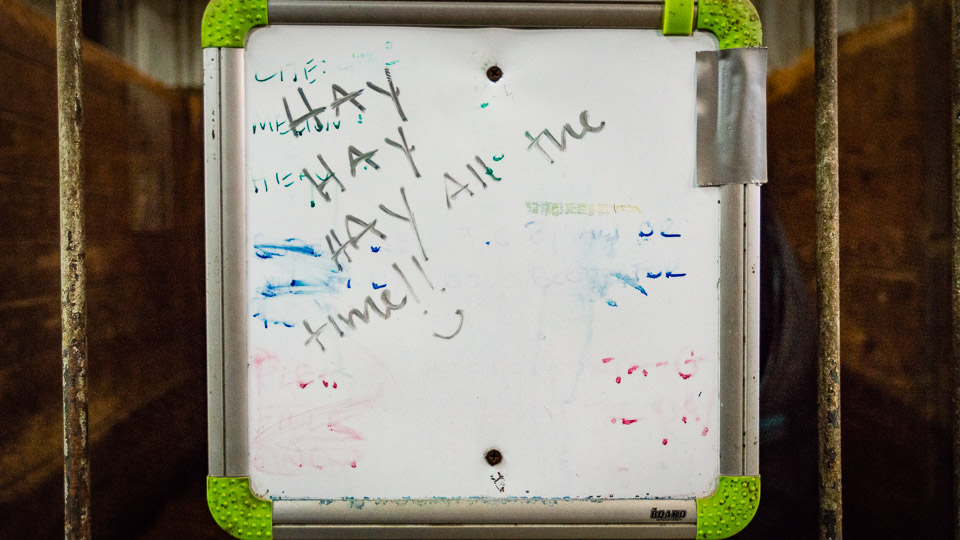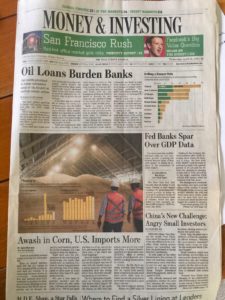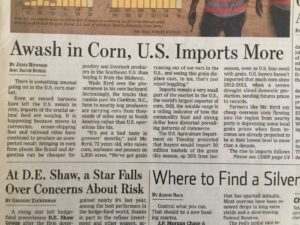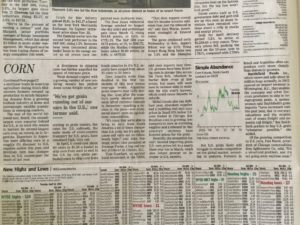
Carbohydrate Dependency – Decomplexicating Equine Nutrition Part 6 of 12
When I enter any convenience store in the United States and walk through all the aisles of food available, I discover just how dependent we are on carbohydrates. After eliminating all items containing grain (corn, wheat, rice and others), grain fed meat (jerky, hard boiled eggs, dairy products), inflammatory oils (vegetable, grain, seed, soy), non-nuts (peanuts and cashews) and artificial sweeteners I am left with water and pistachios. That’s it!
When I enter a feed store for all animals (horses, swine, cattle, goats, sheep, poultry, fish) I see bag after bag of grains, grain byproducts and inflammatory oils. This leaves stacks of hay which is the preserved staple of all equines and ruminants. Poultry should be eating grubs but in stead are fed grain. The fish don’t eat grain except when farm raised where they do.
What Is Hay?
Hay is made of carbohydrates called non-structural carbohydrates (NSC). This is a fancy way of saying starch which is how sugar is stored in plants. This becomes glucose in the gut which is one of the two fuels animals use regularly to produce energy. Hay is also made of structural carbohydrates (SC) which is a fancy way of saying cellulose. The gut bacteria convert this into short chain fatty acids. These become ketones which is one of the two fuels animals use regularly to produce energy. Hay also has protein and other free elements such as minerals and electrolytes. These will be discussed in later blogs.
Early June in NY – It’s time to cut hay.
The ratio of SC to NSC is dependent on many factors such as:
- the time of day the hay is cut.
- if it is baled immediately or left on the ground.
- if the grass grew in shade or directly in the sun.
- if the grass is grown organically or not.
The key point here is that you cannot determine with your eye if the hay has a lot of sugar or does not. The only way to determine the sugar content (NSC) of hay is to have it tested. Every batch of hay you buy will need testing because every truck load and every field it is cut from will be different.
With pasture, you can see that there is a summer productive phase where sugar content will be high and there is a winter dormant phase where the pasture stops growing. This is how it works.
Remember hearing the expression, “The grass grew overnight?” That is because it does. All plants use sunlight to power their factory and gain their fuels from the soil and air. This is the process of photosynthesis. Carbon dioxide is exhaled by you and your horse and contains Carbon and Oxygen. Water has Hydrogen and Oxygen. There you go – C, H and O – the elements needed to make glucose and cellulose. What a cool system! And the exhaust of plants is…. Oxygen used by every mitochondria on the planet to power all animals. The circle of life.
As the sun shines on the plants (grasses and legumes as well as anything else horses will eat) they use photosynthesis to make NSC or starch. This is the fuel they need to grow, reproduce and defend themselves against predators. After the sun sets, photosynthesis stops and the NSC is converted into SC or cellulose. This results in the grass growing overnight. This process repeats until the dormant winter comes and the plants transition into protecting themselves from cold weather and shorter daylight. This is why hay was created. We needed horses to continue to work through the winter and by preserving the summer grass, we were able to keep the horses in good condition for the tasks we had planned for them.
Why Feed Grain To Horses?
Grain was introduced for several logistical reasons. Foremost is that grain is a more dense storage of starch. This made keeping energy easier for long voyages such as across the Atlantic Ocean. Less storage space was needed than with hay. Grain was safer because the chance of fire or dust production from molding hay was less. Today with the surplus of grains in the United States and the high cost of transporting bulk hay, it has become more economical to use grain rather than hay as the energy source for horses. This is even more evident in today’s world where horse owners no longer have pasture enough to sustain their horse or horses.
The economic pressures of owning horses is pushing horse owners into feeding more grain. Lack of pasture, poor quality hay and the rising cost of hay make feeding more grain a logical solution. But the cost in their health is waking owners up to the fact that horses were never meant to eat carbohydrates every day of their lives, especially in a concentrated form. I call this carbohydrate dependency and it is stressing the mitochondria and the insulin systems. In addition, because all grains are soft seeds, they have in the outside skin proteins that are part of the plant’s defense system (lectins – in a later blog). The sole purpose of these proteins is to make the predator (the horse in this case) sick by disrupting the hormone and immune systems. This one – two punch is literally killing horses with disease, lameness and premature death. Yet with all the evidence before us, both the economic pressure and the effectiveness of potent and powerful marketing, grains as a primary feed for horses continues to be fed.
Paying For Left Overs
And as usual, there is more bad news. The Wall Street Journal reports business news and one day it had a front page article titled “Awash In Corn, U.S. Imports More” by Jesse Newman and Jacob Bunge.



Say What? Did I read this correctly? The article said that there was a surplus of corn being stored in the United States. Smithfield Farms, the leading pork producer, was looking to save money so they built a port in North Carolina and imported corn from Brazil and Argentina driving it past our stock piles of corn in trucks because this saved money over paying U.S farmers and the railroad to ship it to their stock yards.
Do you think the corn farms threw out the unwanted corn? Nope. Instead they found more markets including ethanol for our cars and feeding us, our pets and our horses.
Speaking of salvaging things, you will be shocked to read the label of almost every bag of food, treats and supplements you give to your horses. The ingredients of almost every bag I read has 1 to 5 grain byproducts: wheat middlings, oat hulls, rice hulls, soy hulls, wheat bran, rice bran, grain distillers byproducts, sugar beet pulp and more. All of these are after production waste they have you pay for to get rid of through your horse. None of these ingredients are found “in the wild.” And do you remember what I said about the lectins and where they are found? That’s right! In the outside of these grains are proteins that affect your horse in bad ways adding to the carbohydrate overload.
Summary
The only good thing about grain is …. nothing.
Having concentrated carbohydrates available every day, year round is unnatural. It causes strain on the horse’s body systems which take it’s toll on the whole horse. It does this through mitochondrial exhaustion and insulin hormone communication disruption. This results in disease of your horse as well as many unwanted behaviors coming from a horse that just doesn’t feel good.
Just think for a moment. Do horses in the wild have access to grain year round? Do they even have it for more than a week where you live? How about byproducts being available in your pasture? I didn’t think there was any. Then why are we feeding these things when the science is showing that it causes so many problems in both humans, horses and other animals?
Now ask yourself if your horse is doing well on carbohydrate dependency. My point is that carbs may not be bad once in a while and in fact they are necessary and are in all grass in your pasture. It is the year round availability of carbohydrates that is the menace and needs to be stopped if you want to see your horse return to a normal life – the way he has lived for 55 million years without corn, oats, wheat middlings, distillers byproducts, molasses and sugar beet pulp.
Carbohydrate isn’t the only problem in horse nutrition. There are lectins, GMO, pesticides, inflammatory oils, and over supplementation. All to be discussed with the final blog on how you CAN make a difference in your horses.



[…] Carbohydrate Dependency – Decomplexicating Equine Nutrition Part 6 of 12March 1, 2018 […]
[…] dependency (https://theequinepractice.com/decomplexicating-equine-nutrition-part-6-carbohydrate-dependency/) is the root cause of ills and unsoundness in horses today with the secondary development of […]
I respectfully disagee. Have people over grained horses? Absolutely! But that doesn’t mean that grain in and of itself is bad. Totally idle horses, i.e. ” pets” and/ or “easy-keepers” probably don’t require much. Indeed, this category of equines are usually over fed, but truly hard working horses could not consume enough nutrients from just hay or pasture alone. I personally do not like alfalfa hay. It’s great for perverting cattle, but my experience has been that the risks outweigh any benefits. Horse concentrates in whatever form ,need to constantly be adjusted according to the work load and/ or age of a horse, something most trainers, owners, and/ or barn managers have an intense dislike for, even though it is the hallmark of an astute and knowledable horseperson. Just like people, every horse is an individual, and it is our keen eye, and vast knowledge that our horses so depend on, to keep them in the best condition possible. Best regards.
Actually we agree! Back around 2005 I posted a video on YouTube describing the purpose of grain. It is for filling in the energy requirements beyond what a horse can eat in a day from pasture. But back then horses really worked – like pulling goods and people back and forth to the town from the farm or pulling cannons into battle or pulling barges along the canal of pulling wagons across the prairie and mountains or….
The degree of working today may be argued but what cannot be argued is the constant addition of carbohydrates above the horse’s requirements. This leads to accumulation of fat within the muscle making it inefficient. To understand this we need to look at what happens in the muscle and what happens to glucose. When a horse eats any carbohydrate the 1st order of business is to restore the glycogen in the muscle and the liver. Remember that glycogen is in animals what starch is in plants – a place to store glucose for rapid access. Whenever there is more glucose than glycogen storage, the excess glucose is converted into triglycerides (fat) which is stored in the muscle and liver. When these areas are exceeded in their ability to store fat then the excess glucose is stored as body fat. In fact, with mitochondrial exhaustion occurs from carbohydrate dependency, the sugar goes directly to body fat. There is more.
As long as there is glucose present in the food (starch in the forage and in the seeds / grains) then there is insulin and as long as there is insulin circulating, insulin sensitive lipase is inhibited from converting body fat into ketones for fuel and energy production. The result of feeding excess glucose every day is fat accumulation on the body, in the liver and in the muscles. This is NOT the definition of an athlete.
So we agree in that an astute horseman will adjust the amount of glucose intake according to the needs of the individual horse. But in today’s world most horses are not worked that hard, There are exceptions of course. Most horse owners equate feeding horses with love or nurturing but do not understand the consequences of what their feeding programs bring. The result I am seeing throughout this land from FL to NY to WA are an epidemic of connective tissue breakdowns, poor hoof quality including crushed heels and laminitis, poor hair coat, poor top lines, insulin resistance, Cushing’s disease and a host of ailments not even in the vet text books in 1980 (kissing spine, DSLD, EOTRH, white line disease and others). I also see the effects of carbohydrate dependency on people with obesity everywhere I look as well as in the literature I read. Alzheimer’s disease is now considered Type 3 diabetes and children are now contracting Type 2 or “adult onset” diabetes. And in the past 3 years the average lifespan of Americans is decreasing for the first time ever.
This series of decomplexicating equine nutrition is to help people understand that most horses do not need the extra glucose the grains supply. It is also a way of letting horse owners know that it is not just the glucose but the lectins found in the outer layers of seeds. These layers are being removed from the seeds (wheat, rice) and other foods (sugar beets) used for human consumption and rather than discarding them (garbage of fertilizer) they are bagged and sold to unsuspecting horse owners as wheat middlings, rice bran and sugar beet pulp. Where can a horse find grain every day of the year? Where can they find these byproducts every day of the year? Only in the bags of feed that most horses do not need.
So if you have a horse that is working really hard and they obviously need more calories to prevent them from wasting away, consider using straight oats or barley but only enough to prevent fat build up. They have been used for years successfully and judiciously. Remember that feeding them excessively will lead to conversion of protein into sugar and the cascade of events that follow from that. Also remember that feeding young horses grain will not have immediate visible consequences but long term (after 8 to 10 years), that’s when the damage becomes obvious.
Thanks again Sara for your thoughts. Feeding the competitive horse is certainly a balance that astute horse trainers juggle every day. It was easier 40 years ago before feeding the horse became so complexicated.
I would think that a horse that is working hard would do well enough just by adding alfalfa instead of oats or barley.
what do you mena alfalfa is great for perverting cattle? When do you have truly have hard working horses? Rarely.
Peanuts and cashews are considered non nuts? What are they considered?
The peanut is from the legume plant similar to alfalfa. The peanut is part of the root system that is harvested with the remaining plant baled as peanut hay.
Cashews are from the inside of a fruit. While technically a “nut” they are really a seed of a fruit which makes them different from true nuts which are seeds that have a hard outer shell (not a fruit). Think walnut, almond or pistachio. Most nuts are seeds, but not all seeds are nuts (wheat, oats, etc).
Confused? That is because the culinary world lumps peanuts and cashews with nuts but in the botanical world they are different.
I have been grain free for 2 months now! Horses are calmer and not as grumpy. My racebred 3year old has not bolted since the new diet. Thank you. My 17 year old barrel horse needs some kind of joint supplement but all I can find has a ton of sugar in it. Do you have any insights on a good joint supplement? Also I would like to know more of the nuts and bolts of suspensory tendon soreness you said is a byproduct of the bad diet. My barrel horse struggled with that forever. He is much much better in the last 2 weeks (go figure!)thank you !!!!!
Thanks Maria for trying the no grain diet and discovering for yourself the benefits. This testimony will help others deciding to do this too.
All joint supplements have sugar because they are sugars! But they are not simple sugars just like the mucopolysaccharide (mucus) that lines your intestinal tract is a sugar. Remember that sugars are not evil. They are required for us to live. However the daily intake of simple sugars (grains, fruits, etc) will lead to carbohydrate dependency and eventually mitochondrial exhaustion, insulin resistance and chronic protein deficiency. The medium chain sugars of glucosamine added as a dietary supplement will bind to the lectins in the diet and hold them within the lumen for elimination. What you put in as a supplement is pooped out with the offending lectin which would have otherwise made it into the body and the joint fluid to cause arthritis. In fact in humans, they are now finding lectins and lipopolysaccharides (LPS) in the joint fluid causing the joint irritation.
The epidemic of suspensory ligament issues I see everywhere is what started me looking at nutrition. They were not a problem in the 70’s and 80’s. After the accessibility of grains for all horses everywhere it seemed that the incidence of suspensory injuries escalated. My suspicion is the gluconeogenesis that occurs when the cells start to starve from the mitochondria becoming exhausted. See my other blogs for details or enroll in the nutrition course.
Hi Doc T,
I have a question, I have a mare that is IR and has had two episodes of laminitis.First time was 2 yrs ago. We sold our home where she was on pasture 24/7 no grain and moved to our new home where there was no pasture for a year. I had her on hay and a supplement/balancer. Once the pasture was back I let her out on it she was fine for the first couple months then got laminitis. I got her thru that and for the next year she did fine on pasture spring thru early winter. This January we got a cold snap and boom she got laminits again. So back to hay and a supplement. The more I read your articles the more I am convinced I don’t need to add anything, no supplement. I thought that there was a need for them to make up for what is lacking in the hay. I am going to stop all supplements, stick to hay. I also leave out free choice Red Cal salt and mineral supplement. Do you think the Red Cal or Red Cal Mag is okay alone or do I need to give other salt? During her laminitis episode she tended to eat quite a bit of it, I was thinking she was lacking something.
I can’t reply directly to your case.
Salt without minerals and sugars is fine.
All hay is summer grass and therefore has a starch component. You need to remove this sugar by soaking the hay.
I find most people in your situation are not feeding any protein to help the hooves. Please read the next blog on protein to understand that without enough variety of protein, the hoof will be weak.
Hi Geoff, wow. I am really behind on reading this awesome info on horse nutrition, I caught up and read it all today. I really need to admit it has been one of my true shortcomings. I have had so little knowledge and understanding of the horse’s nutritional needs. I of course have seen the benefits of the no grain challenge. Thankfully my horses do lead a grain free life. The meals they get in a bowl is soaked Timothy pellets and some Celtic Sea salt. Of course they get lots of time on pasture and hay. I really look forward to hearing about the salt you prefer, and what if any supplements should be given. AND balancer, seems so many people are using balancer.
For everyone, Ducka and I go way back to my first days at Cornell. It is interesting that all this information wasn’t available there or at any other vet school. What was available was masked in confusing statements, yet I used Dr Hintz’s text for much of the information as the material and research is still relevant. But putting it all together has led to missing pieces such as this idea of carbohydrate dependency.
Thanks for becoming grain free. Any pure salt will work. Iodine deficiency is rare in horses so if you want to use iodized salt that’s OK. Salt with sugars added such as the trace mineral salt blocks should be avoided. Any sea salt or rock salt the horse wants to eat is OK.
Part 10 is about vitamins, minerals and electrolytes. Your answers will be there.
As always another great article. Thank you Doc!
This is fun!!! Glad you are enjoying.
Thank you for educating us. It is areal eye opener. What are you thoughts on feeding alfalfa pellets
? Look forward to hearing from you. Marianne
Alfalfa is a good feed for most horses and the pelleted version is convenient. I think that about 1 flake’s worth a day is enough for most. If your horse is one of the few that gets soft feces or squirts or even becomes “hot” then don’t feed them until the gut has a chance to reestablish the normal gut microbiome. This may take up to a year if he has had a lot of medicines (any medicines).
I am so happy for the education. Dr. T. My usual feed store ran out of soybean meal so I called around to other feed stores. I could only find soybean pellets. When I looked at the ingredients it was full of grain and carbs…exactly as you said. So glad I knew not to buy anything with grain in it. Thanks again!
This is a great example of how important it is to reed the ingredient label. Thanks!